Radio Buffs Lobby to Make Historic 500 kHz a ‘Memorial Frequency’
For almost a century, 500 kHz was a lifeline for ships worldwide. Better known as 500 kilocycles, it was the spectrum reserved for ships and the shore stations that communicated with them in Morse Code (sometimes referred to as CW, for continuous wave).
If you’re a real radio old-timer, you might refer to the frequency as 600 meters.
“To ensure that SOS calls were always heard, all ship and shore stations were required to monitor 500 kHz at all times,” said Richard Dillman, secretary and chief CW operator of the Maritime Radio Historical Society. “At 15 and 45 minutes past the hour, all users were required to go silent, so that any weak SOS calls could make it through.”
Over the years, countless distress calls were transmitted and heard on 500 kHz, including those from the Titanic. In fact, it was Titanic’s loss that inspired the 500 kHz monitoring rules.
But even in recent times, 500 kHz has been a lifesaver. For instance, when the Holland America passenger ship Prinsendam caught fire and sank in the Gulf of Alaska on Oct. 4, 1980, it was Morse via 500 kHz that brought help. As for the Prinsendam’s high-tech satellite radio system? It failed. Without Morse and 500 kHz, help would have arrived too late.
With the demise of commercial Morse traffic, 500 kHz – “we still call it 500 kc,” said society President Tom Horsfall – has fallen mostly silent around the world. Exceptions are events such as the annual MHRS’ “Night of Nights” Morse broadcasts from restored RCA shore station KPH near San Francisco, which is maintained by society volunteers and the National Parks Service.
“At least two – and soon three – historic ships that have valid ship station licenses use 500 kc to communicate with each other and KPH and KSM,” he said. As well, “Recently coast station KLB in Seattle restored operation on 500 kc.”
Amateur radio operators are interested in the spectrum. But given the frequency’s august history, Dillman, Horsfall and other society members are lobbying to have 500 kHz designated as a “memorial frequency.” This, they say, would prevent the spectrum being reallocated by the International Telecommunication Union and keep 500 kHz open for future Morse events such the Night of Nights, which attract listeners around the world.
Dillman is not aware of any similar designation. “The concept of an International Memorial Frequency … originated with the MRHS,” he said. “While we can’t speak for the ITU, I think we can say without fear of contradiction that no other frequency has been so designated.”
‘Sacrilege’
At first, the notion of preserving a piece of radio spectrum as a historic “site” might seem strange. After all, spectrum is not tangible, like a building or artifact, so how can one “preserve” it?
Dillman and Horsfall become passionate about the topic. Arguing that the actual amount of bandwidth removed from use would be “a tiny slice,” they say reallocating 500 kHz to other uses would be “sacrilege.”
“We’ve spoken to ship and shore radio operators around the world, and they generally agree that 500 kc is ‘hallowed ground,'” said Dillman. “That’s why they are hoping that the ITU will agree to setting 500 kc aside as a memorial frequency.”
Some ham radio operators seem none too keen about setting 500 kHz off-limits. “This is going too far!” wrote one ham at www.eham.net “History is important, granted, but the fact that many very talented old-timers are growing older and older does not justify turning the radio waves into a memorial. Gads! This is gross!”
(Made aware of this comment, Dillman replied, “Of course the fact that old-timers are old has nothing to do with our proposal.”)
Another ham wrote, “I think they should just reallocate 500 kHz for amateur use and then these historical coastal stations can share it as secondary users under that same proposal. I do not agree that 500 kHz should be specifically allocated for historical station use only.”
Other hams defend the society’s idea. Wrote one ham, “These folks and their organizations are part of commercial maritime radio. They use 5-20 kW transmitters. None of their frequency allocations are in the Amateur Radio Service. In fact, in their proposal for the International Memorial Frequency they state: ‘It is important to note that this proposal is not intended to establish a new frequency in the amateur radio service. In fact the aim is quite the opposite.'”
“We don’t want anything to change,” Horsfall emphasized to Radio World. “We would like all authorizations to stay the same, with the addition that each ITU signatory country could license legitimate historic marine radio projects to use 500 kc.”
A decision whether to “memorialize” 500 kc would be made by the ITU. To this end, the MRHS is lobbying contacts within the international body, hoping that they will help turn the MRHS’ dream into reality. Dillman said the concept of an International Memorial Frequency has been presented informally to the ITU by a supporter of the idea who attends its meetings.
“At the moment the ITU has not expressed an opinion on the concept,” he said.











